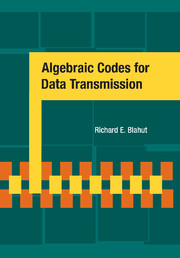Book contents
- Frontmatter
- Contents
- Preface
- Dedication
- 1 Introduction
- 2 Introduction to Algebra
- 3 Linear Block Codes
- 4 The Arithmetic of Galois Fields
- 5 Cyclic Codes
- 6 Codes Based on the Fourier Transform
- 7 Algorithms Based on the Fourier Transform
- 8 Implementation
- 9 Convolutional Codes
- 10 Beyond BCH Codes
- 11 Codes and Algorithms Based on Graphs
- 12 Performance of Error-Control Codes
- 13 Codes and Algorithms for Majority Decoding
- Bibliography
- Index
6 - Codes Based on the Fourier Transform
Published online by Cambridge University Press: 05 June 2012
- Frontmatter
- Contents
- Preface
- Dedication
- 1 Introduction
- 2 Introduction to Algebra
- 3 Linear Block Codes
- 4 The Arithmetic of Galois Fields
- 5 Cyclic Codes
- 6 Codes Based on the Fourier Transform
- 7 Algorithms Based on the Fourier Transform
- 8 Implementation
- 9 Convolutional Codes
- 10 Beyond BCH Codes
- 11 Codes and Algorithms Based on Graphs
- 12 Performance of Error-Control Codes
- 13 Codes and Algorithms for Majority Decoding
- Bibliography
- Index
Summary
Applications of the discrete Fourier transform in the complex field occur throughout the subject of signal processing. Fourier transforms also exist in the Galois field GF(q) and can play an important role in the study and processing of GF(q)-valued signals, that is, of codewords. By using the Fourier transform, the ideas of coding theory can be described in a setting that is much closer to the methods of signal processing. Cyclic codes can be defined as codes whose codewords have certain specified spectral components equal to zero.
In this chapter we shall study cyclic codes in the setting of the Fourier transform. In the next chapter, we shall study decoding algorithms for cyclic codes. The most important classes of cyclic codes studied in this chapter are the Reed–Solomon codes and their subcodes, the Bose–Chaudhuri–Hocquenghem (BCH) codes.
The BCH codes form a large class of multiple-error-correcting codes that occupy a prominent place in the theory and practice of error correction. This prominence is due to at least four reasons. (1) Provided the blocklength is not excessive, there are good codes in this class (but generally, not the best of known codes). (2) Relatively simple and implementable encoding and decoding techniques are known (although, if simplicity were the only consideration, other codes may be preferable). (3) The popular and powerful class of nonbinary BCH codes known as Reed–Solomon codes has a certain strong optimality property, and these codes have a well-understood distance structure.
Information
- Type
- Chapter
- Information
- Algebraic Codes for Data Transmission , pp. 131 - 178Publisher: Cambridge University PressPrint publication year: 2003
Accessibility standard: Unknown
Why this information is here
This section outlines the accessibility features of this content - including support for screen readers, full keyboard navigation and high-contrast display options. This may not be relevant for you.Accessibility Information
- 1
- Cited by
